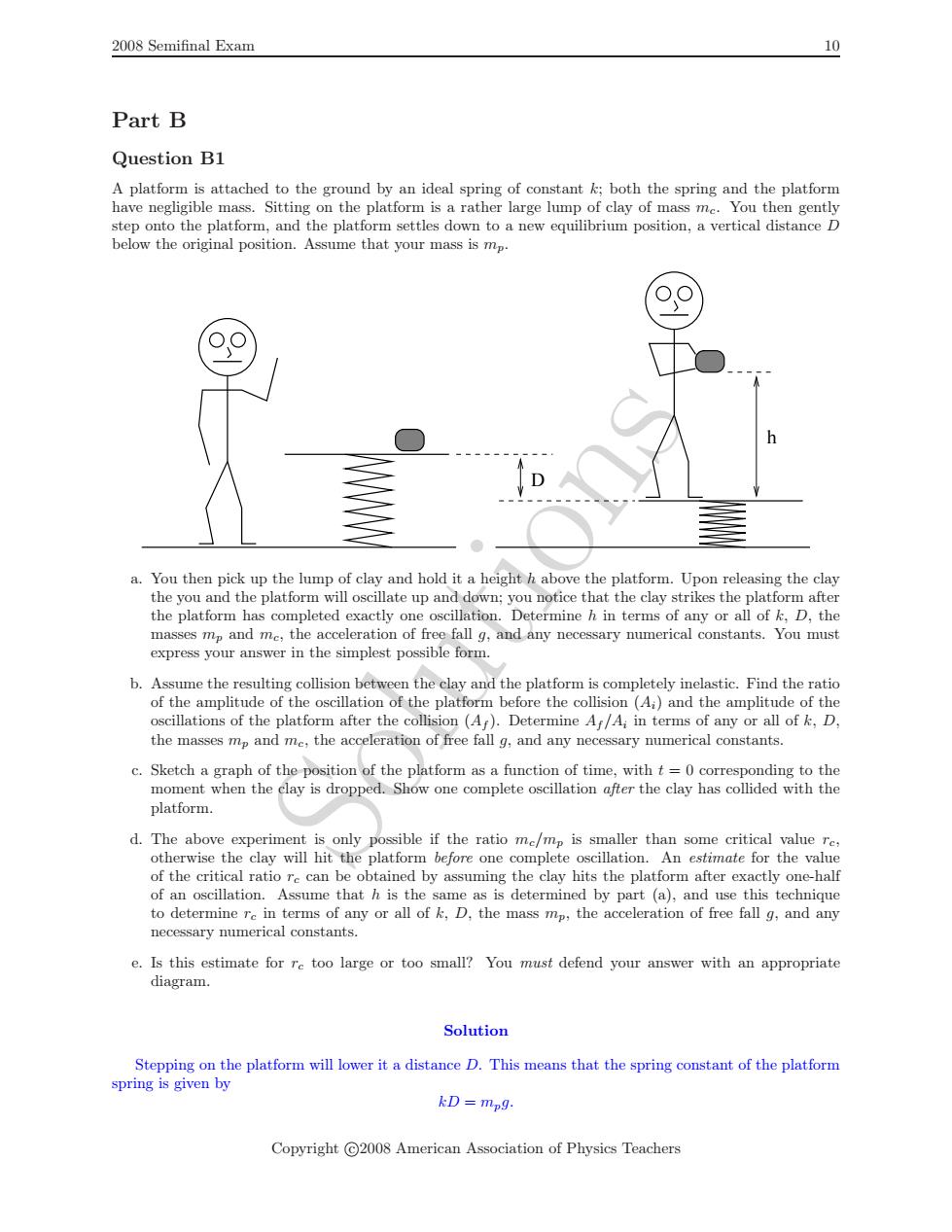正在加载图片...

2008 Semifinal Exam 10 Part B Question B1 A platform is attached to the ground by an ideal spring of constant k;both the spring and the platform have negligible mass.Sitting on the platform is a rather large lump of clay of mass me.You then gently step onto the platform,and the platform settles down to a new equilibrium position,a vertical distance D below the original position.Assume that your mass is mp. h a.You then pick up the lump of clay and hold it a height h above the platform.Upon releasing the clay the you and the platform will oscillate up and down;you notice that the clay strikes the platform after the platform has completed exactly one oscillation.Determine h in terms of any or all of k,D,the masses mp and mc,the acceleration of free fall g,and any necessary numerical constants.You must express your answer in the simplest possible form. b.Assume the resulting collision between the clay and the platform is completely inelastic.Find the ratio of the amplitude of the oscillation of the platform before the collision (A:)and the amplitude of the oscillations of the platform after the collision (Af).Determine Af/Ai in terms of any or all of k,D, the masses mp and me,the acceleration of free fall g,and any necessary numerical constants. c.Sketch a graph of the position of the platform as a function of time,with t=0 corresponding to the moment when the clay is dropped.Show one complete oscillation after the clay has collided with the platform. d.The above experiment is only possible if the ratio me/mp is smaller than some critical value re, otherwise the clay will hit the platform before one complete oscillation.An estimate for the value of the critical ratio re can be obtained by assuming the clay hits the platform after exactly one-half of an oscillation.Assume that h is the same as is determined by part (a),and use this technique to determine re in terms of any or all of k,D,the mass mp,the acceleration of free fall g,and any necessary numerical constants. e.Is this estimate for re too large or too small?You must defend your answer with an appropriate diagram. Solution Stepping on the platform will lower it a distance D.This means that the spring constant of the platform spring is given by kD =mpg. Copyright C2008 American Association of Physics TeachersSolutions 2008 Semifinal Exam 10 Part B Question B1 A platform is attached to the ground by an ideal spring of constant k; both the spring and the platform have negligible mass. Sitting on the platform is a rather large lump of clay of mass m c. You then gently step onto the platform, and the platform settles down to a new equilibrium position, a vertical distance D below the original position. Assume that your mass is m p . D h a. You then pick up the lump of clay and hold it a height h above the platform. Upon releasing the clay the you and the platform will oscillate up and down; you notice that the clay strikes the platform after the platform has completed exactly one oscillation. Determine h in terms of any or all of k , D, the masses m p and m c, the acceleration of free fall g, and any necessary numerical constants. You must express your answer in the simplest possible form. b. Assume the resulting collision between the clay and the platform is completely inelastic. Find the ratio of the amplitude of the oscillation of the platform before the collision ( A i) and the amplitude of the oscillations of the platform after the collision ( A f ). Determine A f /A i in terms of any or all of k , D , the masses m p and m c, the acceleration of free fall g, and any necessary numerical constants. c. Sketch a graph of the position of the platform as a function of time, with t = 0 corresponding to the moment when the clay is dropped. Show one complete oscillation after the clay has collided with the platform. d. The above experiment is only possible if the ratio m c/m p is smaller than some critical value r c , otherwise the clay will hit the platform before one complete oscillation. An estimate for the value of the critical ratio r c can be obtained by assuming the clay hits the platform after exactly one-half of an oscillation. Assume that h is the same as is determined by part (a), and use this techniqu e to determine r c in terms of any or all of k , D, the mass m p, the acceleration of free fall g, and any necessary numerical constants. e. Is this estimate for r c too large or too small? You must defend your answer with an appropriate diagram. Solution Stepping on the platform will lower it a distance D. This means that the spring constant of the platform spring is given by kD = m pg. Copyright c 2008 American Association of Physics Teachers